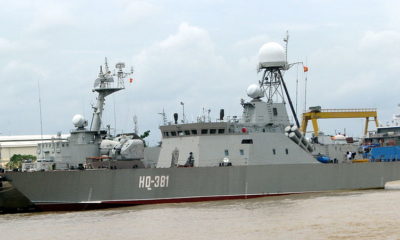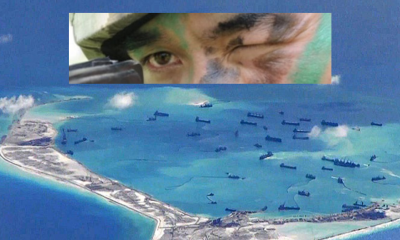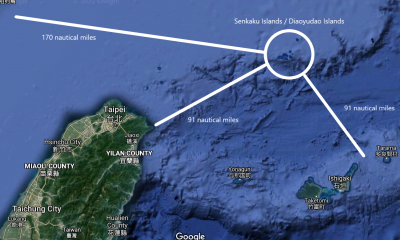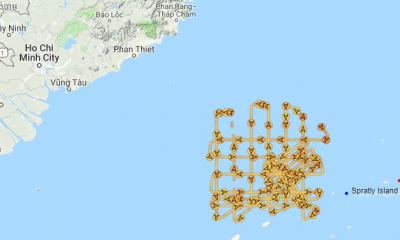(76 mm Cannon in China Coast Guard ships)
Nguyen Luong Hai Khoi
China’s Campaign to intrude into the Continental Shelf and EEZs of Southeast Asian Countries in 2019 (Part 1: Process of the campaign, Part 2: Military tactics of the campaign, Part 3: Legal Aspects of the campaign)
In the summer of 2019, China launched a major campaign to intrude into Southeast Asian countries’ continental shelves and exclusive economic zones in the South China Sea. In this intrusion campaign, China applied several military tactics for the first time such as cooperation between military and civilian forces, stretching Vietnam’s Coast Guard force from north to south by simultaneously deploying two intrusions in two different locations. By identifying and analyzing Chinese tactics, we can speculate on China’s future moves.
Chinese Forces Deployed During the Intrusion Campaign
China mobilized the following ships to intrude into the Southeast Asian countries’ continental shelves and exclusive economic zones in the South China Sea from July to October 2019.

Combined information from Naval War College Review, South China Sea Chronicle Initiative, and Marine Traffic. (Haijing 46301 is also known as China Coast Guard (CCG) 5303, is 138 meters long, and is “one of China’s advanced Type 818 Zhaoduan-class cutters which sports a 76-mm cannon.” See AMTI)
China’s Tactic of Stretching the Forces of ASEAN Countries While Intruding into Their EEZs
In early September 2019, while the survey vessel HYDZ-8 and many of China Coast Guard’s ships intruded deep into southwestern Vietnam’s exclusive economic zone to survey an area just over 80 nautical miles from the coast, China deployed China National Offshore Oil Corporation’s crane vessel Lan Jing. The vessel entered Vietnam’s territorial waters in the Central region located north of the area where HYDZ-8 was surveying at that time. According to data from Marine Traffic, on September 3, 2019, Lan Jing entered Vietnam’s 12 nautical miles of territorial waters based on the baseline in central Vietnam.
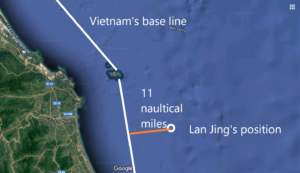
The crane vessel Lan Jing moved in a zigzag pattern from September 1 to 3, 2019 in a single area in Vietnam’s territorial waters.
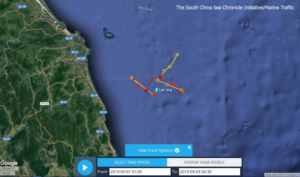
Lan Jing’s path from September 1 to 3, 2019. The route of this crane ship showed that it did not make an innocent passage through Vietnam’s territorial waters. (Photo: South China Sea Chronicle Initiative)
The crane vessel Lan Jing has the right of innocent passage within Vietnam’s 12-nautical-mile territorial sea, but its zigzag pattern movement over three consecutive days shows that this vessel was surveying Vietnam’s seabed in this area. At the same time, the HYDZ-8 was entering Vietnam’s southwestern sea area just over 80 nautical miles from the coast. These two actions demonstrated that China had mobilized different forces to stretch Vietnam’s Coast Guard police.
China Coast Guard’s Operational Art in the South China Sea
During the intrusion campaign into Malaysia and Vietnam’s exclusive economic zones and continental shelves in the summer of 2019, China’s Coast Guard practiced joint warfare operational art.
Zhaotou, Zhaoduan, and Zhaojun are China’s three main classes of Coast Guard ships. They carry out China Coast Guard’s strategy to move to the “far sea” and suppress other countries’ Coast Guard forces in their exclusive economic zone. China has nine ships of the Zhaotou class, six of the Zhaoduan class, and two of the Zhaotou class. (See: Erickson, Andrew S .; Hickey, Joshua; and Holst, Henry (2019) “Surging Second Sea Force: China’s Maritime Law-Enforcement Forces, Capabilities, and Future in the Gray Zone and Beyond,” Naval War College Review: Vol. 72: No. 2, Article 4. p.14).
In the campaign to intrude into and survey Malaysia and Vietnam’s continental shelves and exclusive economic zones from July to October 2019, China deployed half of the most modern ships mentioned above.
The China Coast Guard ships that participated in the campaign to intrude deep into Vietnam and Malaysia’s continental shelves and exclusive economic zones were heavily armed vessels similar to warships.
Zhaotou-class Coast Guard ships are equipped with helicopters, interceptor boats, deck guns, and high-capacity water cannons. The water cannon fitted to the Zhaotou Class Vessel “demonstrated their ability to inflict damage by breaking pilothouse windows, damaging bridge-mounted equipment, forcing water down exhaust funnels, and breaking bones of crew members on Vietnamese vessels” during the Haiyang Shiyou (HYSY) 981 rig’s foray into Vietnam’s exclusive economic zone in 2014.
The Zhaoduan (Type 818) is the China Coast Guard’s newest and fastest class which was revamped from the People’s Liberation Army Navy’s Jiangkai II (Type 054) guided-missile frigate. This type of Coast Guard vessel is armed with a 76 mm gun similar to the Jiangkai II warship. It is also equipped with two additional 30mm guns and an armed helicopter. Powered by a warship’s engines, it is the fastest coast guard ship in the world.
Zhaojun is equipped with an armed helicopter, a 76 mm cannon, and an interceptor boat. (See: Erickson, Andrew S.; Hickey, Joshua; and Holst, Henry (2019), ibid, p. 15-16). In addition to deploying a coast guard force armed with powerful weapons, China practiced a cooperative strategy between armed ships and civilian ships in this intrusion campaign by utilizing the HYDZ-8 survey vessel, the guard ships, and the crane vessel Lan Jing of China National Offshore Oil Corporation (CNOOC). Although China did not deploy helicopters in this campaign, it has the power to coordinate the combat operations of coast guard ships and aerial combat helicopters in the future because Zhaotou and Zhaoduan classes coast guard ships are designed with armed helicopters.
During the intrusion campaign China Coast Guard’s vessels in charge of the East China Sea, such as 31302, 33111, 37111, 33111, 35111, were dispatched to the South China Sea. In 2014, when moving the Hai Yang Shi You 981 oil rig to the location 120 nautical miles off Vietnam’s baseline, China also mobilized many coast guard ships from other sea areas to the South China Sea in order to intimidate Vietnam.
Since July 2018, the China Coast Guard has been under the armed police force, directly led by the Chinese Central Military Commission (See “Xinhua Daily”: 组建 中国 人民 武装警察 部队 海 警总队 [“Formation of the Chinese People’s Armed Police Force: China Coast Guard under the Chinese People’s Armed Police”]). China’s campaign to intrude into Southeast Asia’s exclusive economic zones and continental shelves in 2019 lasted three months. The campaign mobilized China Coast Guard forces from many different areas of water and coordinated with civilian forces to proceed simultaneously into the continental shelves of many countries. These phenomena indicate that the campaign was approved by the Chinese Central Military Commission.
The China Coast Guard forces are stronger than all of the coast guard forces of Southeast Asian countries combined. Vietnam and other Southeast Asian countries in the South China Sea have no proper strategy to deal effectively with the large opponent.
Related articles
China’s Campaign to intrude into the Continental Shelf and EEZs of Southeast Asian Countries in 2019 (Part 1: Process of the campaign, Part 2: Military tactics of the campaign, Part 3: Legal Aspects of the campaign)

 Politics & Economy3 years ago
Politics & Economy3 years ago
 Society & Culture4 years ago
Society & Culture4 years ago
 ARCHIVES4 years ago
ARCHIVES4 years ago
 Politics & Economy3 years ago
Politics & Economy3 years ago
 Politics & Economy4 years ago
Politics & Economy4 years ago
 Politics & Economy3 years ago
Politics & Economy3 years ago
 Politics & Economy4 years ago
Politics & Economy4 years ago
 ARCHIVES3 years ago
ARCHIVES3 years ago







